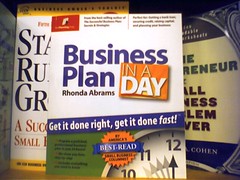
- Image by Raymond Yee via Flickr
What is the best way to write a business plan? And, how do you get it done without losing your sanity? And, without the “analysis-paralysis“?
Using and writing a business plan template will be important, and you can use the below to begin. And, if you have investors or partners, a business plan proposal will be important. It’s your “ultimate” business card!
I get a lot of questions around making a business plan, and it’s hopefully obvious that I can’t go over all of the finer points of the art of drawing up business plans in a single blog entry – but I can try. (Tip: you should compare notes and ask around in your local business community and network of others that can help you too).
9 Considerations for Your Business Plan Layout:
And – for a more detailed approach, you can use business planning software, and I’ve used several, but keep coming back to the Palo Alto Business Planning software. It has over 500+ sample business plan templates you can use to start.
Here’s a quick structure for you:
1. Executive summary. This is a summation, usually no longer than 3 or 4 pages (but can get longer depending on how long the business plan itself is) that hits on all the main points. Write this first. We’re serious. It helps you as an outline; it’s often the only part that some people will ever read of your plan. It’s important.
2. Table of contents. Easy to follow.
3. Company description. Brag about your company, but brag factually!
4. Product/services sold. Use layman language – it will appeal to a wider audience.
5. Market analysis. Show your stuff. Some examples of things to discuss include employee relations, industry characteristics and trends, projected growth, complementary products, similar products in the market, etc. Basically, show that you know what you’re doing and you’ve got the factual background to prove it.
6. Marketing plan. What’s your plan? How do you plan to climb to the top of your particular market? Numbers will be important, but have a system of marketing in place.
7. Management. Got somebody on your team with a successful entrepreneurial background? Work it. Investors may and will choose the group with the subpar product and the superstar team rather than the ingenious product with no credentials supporting the people who are selling it. (Note: If Steven Jobs left, would the company survive still? Even with great products?)
8. Exit strategy. This isn’t for you – it’s for the investor. And while it’s not strictly required, look to see if you can offer the investor a way out of the investment, be it a merger, acquisition, or by other means. Again, it’s not required, but it shows that you have the investor in mind when it comes to your plans to take over the market world. Investors like these.
9. Appendices. Marketing team resumes, promo materials, product photos, etc. Make sure that these are actually necessary. Clutter is still clutter.
What approach have you used to your own business planning? Do you think it’s necessary if you don’t have investors or partners?
Related articles
- Analysis of a Business Plan (thinkup.waldenu.edu)
- What Is The Purpose of A Business Plan? (kevinwmccarthy.com)
- The Business Plan Or Planning For Business – What Works Today (growvc.com)